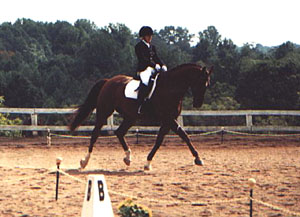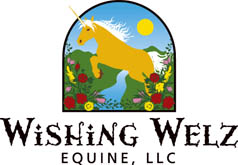
The Long Road Back to Soundness
by Linda Fragale ©2006

Above: Artie and Linda in action. A barefoot program helped him regain his soundness and movement. Photo courtesy Linda Fragale.
Three years ago, after just receiving the final score I needed
to obtain my USDF Bronze Medal, my Third Level horse, Artist (Artie), came up
lame. Actually, it started over the course of several months, with a training
session here and there where he felt the all-too-familiar “not quite right.”
Sometimes he felt lame in the hind end; then after getting re-shod, he felt
lame in the front.
Finally, one day Artie was put into the wrong paddock, and so
he ran all over the place—only to come up obviously lame the next day in
the left hind. This time, the lameness persisted. I then called out the vet.
My regular vet was out of town, so her temporary replacement came out; he specialized
in lamenesses. He did a full workup and watched him lunge. In watching the horse
go, he confirmed the left hind lameness, but also commented that the horse appeared
short on his left front, also. We focused on the hind end, since it was a more
pronounced lameness. After several nerve blocks, we narrowed the problem (we
thought) down in the fetlock area. A sonogram presented an area in the deep
digital flexor tendon that looked like a tear. He said this can be a career-ending
injury (to which I sobbed). He recommended surgery at Morven Park.
So I took Artie to Morven Park; they re-sonogrammed the leg, and
the spot that the other vet had seen was also evident on the other leg—so
that was apparently a normal “spot” for this horse. They did, however,
say that the annular ligament was thickened and that it needed to be split to
allow more flexibility in the joint. They said THAT was causing the lameness.
So Artie was left at Morven for surgery. They went in and split
the ligament and said that, while they were in there, they found a tear in the
superficial flexor tendon and they repaired that, as well. That tear did not
show up on the sonogram. Rehab, of course, included lots of stall rest and hand-walking,
until the follow-up appointment with the vet several weeks later. On re-examination,
the horse was sound. So I was off to my slow riding build-up (walking, to one
min. trot, then 2 min., etc.).
Artie stayed sound for a couple of weeks, then went lame, so I
took him back to Morven. Then I was told that the horse had been lame from the
tear in the tendon—not the thickened annular ligament (reverse of what
I was told before). On examination again, they then went up the leg and determined
that he was lame in the hock. I couldn’t buy that, but let them x-ray and
inject his hock. A couple of rides later, the horse went lame again. I took
him back up to Morven, at which point they said the lameness was in FRONT, and
to put shoes on him. Took him home, put shoes on. Still lame… Now we are
into almost a year of this nonsense, and I still have no diagnosis.
My vet came out and recommended putting degree pads on the left hind, to shorten
the tendon and offer it some relief, then slowly lower the pads until they were
not needed. I was skeptical, but thought I had nothing to lose, and put them
on. One week later, I realized that was a huge mistake, and pulled all the shoes
and threw Artie outside 24/7.
Totally frustrated and out of money, I posted a notice on Ultimate
Dressage website about donating my horse. I received a response from a girl
in South Carolina who said she has had a lot of success w/rehabbing horses just
like Artie—please send her a tape, so she could take a look at his movement
(I had videos of him from shows.) She was instantly interested, and commented
that it should take several months, but that he should go sound, and she would
see how far he was willing/able to go in dressage. I replied that apparently
she should have been a VET, because how did SHE think she would make my horse
sound. Once she found a trailer to borrow, she would be on her way to pick up
Artie.
She had told me what the rehab would consist of. She does a high
performance barefoot trim—no farrier I had ever met had done that. She
left the horses out 24/7, to provide constant movement, particularly for the
rehab horses, as more movement/more blood flow means quicker healing. This apparently
had worked for horses she took that had foundered, who had “navicular,”
were extremely contracted, etc. Meantime, I started corresponding with a woman
in Canada, Lisa Huhn with Equinextion, who was telling me the same things this
other girl was. I visited the Canada website and studied all the articles and
case stories. Two days before the SC girl was to pick up Artie, I cancelled
on her! I wanted to try this different approach; what did I have to lose?
This new barefoot approach takes into consideration the whole
horse, the mechanics of the foot and how to trim the foot to allow the foot
to function properly. When the foot is allowed to work properly and WITHOUT
SHOES, virtually any undesirable problem with the horse can DISAPPEAR!!! The
biggest example is the “NQR”—“not quite right syndrome”;
also navicular, founder, laminitis, contracted heels, white line disease, thrush,
heaves, hives, other skin problems, girthiness, head tossing, training “issues,”
the list goes on... they DISAPPEAR.
So many times, vets go everywhere but the foot to diagnose lameness
issues. But over 90% of lamenesses occur in the foot! NOW I had an explanation
as to why the vets could not diagnose my horse’s lameness. I do believe
that it started out as a soft tissue problem behind, caused by compensating
for pain. Then the front foot lameness obviously came from the (shod) front
feet.
As I think back over the past several years of working with Artie
when I could NOT get a light canter even though he was BORN uphill—his
movement had been deteriorating, but he was such a big, scopey mover that the
change was overlooked/not really noticed.
I now have a whole barn full of barefoot horses who move better than they EVER
have, and are as healthy as can be. I have also had Lisa Huhn, the woman from
Canada, down twice to get us started on the high performance barefoot trim,
and I am now trimming my own horses, as well as a few outside horses.
Three years later, and we just competed in a show at Morven Park
that was the three year anniversary of the last show I had done with Artie.
He was brilliant, sounder than ever and got a 65% on Second Level Test 2! His
movement as a two year old is back and here to stay!
I beg anyone who is struggling with soundness issues to pursue
this new barefoot approach! Even if your horse is “sound,” please
consider barefoot, and be amazed at the improvement to your horse’s performance
and behavior.
About the author: Linda Fragale has a B.S. Degree in Equestrian Studies and is a USDF “L” graduate, judging schooling shows throughout Virginia. She has competed through Third Level Dressage and Training Level Eventing. She has been teaching for over 20 years and has worked with students of all ages, including working extensively with Pony Club.
This article was printed in issue 24 of The Horse's Hoof Magazine.
To order your subscription, please visit The
Horse's Hoof Store
©2006 by The Horse's Hoof. All rights reserved. No part of these publications may be reproduced by any means whatsoever without the written permission of the publisher and/or authors. The information contained within these articles is intended for educational purposes only, and not for diagnosing or medicinally prescribing in any way. Readers are cautioned to seek expert advice from a qualified health professional before pursuing any form of treatment on their animals. Opinions expressed herein are those of the authors and do not necessarily reflect those of the publisher.
The Horse's Hoof Website
Home - About Us -
Articles - Barefoot Performance - Barefoot
Stories - Hoof Gallery
- Natural
Horse Care - EPSM
- Events - Trimmers
- Experts - Friends
- Classified - Resources
- News - Links
- Strasser
Hoofcare Links
To go shopping or subscribe to our magazine, please click here: The
Horse's Hoof Store
If you don't see a column to the left: To view the frames version of this site, please click here: TheHorsesHoof.com
The Horse's Hoof is a division of:

The Horse's Hoof
P.O. Box 1969
Queen Creek, AZ 85142
Phone (623) 935-1823
Message Phone: 1-623-935-1823
(Leave a message anytime.)
Email: editor @ TheHorsesHoof.com (delete spaces)